When facing plumbing emergencies, you should be prepared for issues like leaky faucets, clogged drains, running toilets, burst pipes, and faulty water heaters. Leaky faucets waste water, while clogged drains can lead to backups. Running toilets can considerably increase your water bill, and burst pipes often require immediate action to avoid flooding. Water heater problems can disrupt your hot water supply, and garbage disposal malfunctions can bring your kitchen to a halt. Regular maintenance helps prevent these incidents, so stay vigilant. Knowing these common issues can equip you with the right tools to address them effectively and proactively.
Key Takeaways
- Leaky faucets can waste thousands of gallons annually; timely repairs are essential to prevent water waste and maintain fixture lifespan.
- Running toilets may waste up to 200 gallons a day; common fixes involve replacing faulty flappers or adjusting float mechanisms.
- Burst pipes can result from freezing temperatures or corrosion; immediate action is crucial to prevent extensive water damage.
- Clogged drains require prompt attention; use plungers or snakes for minor issues, and avoid harsh chemicals that can damage pipes.
- Sump pump failures can lead to flooding; regular maintenance is necessary to ensure proper function during heavy rainfall.
Leaky Faucets
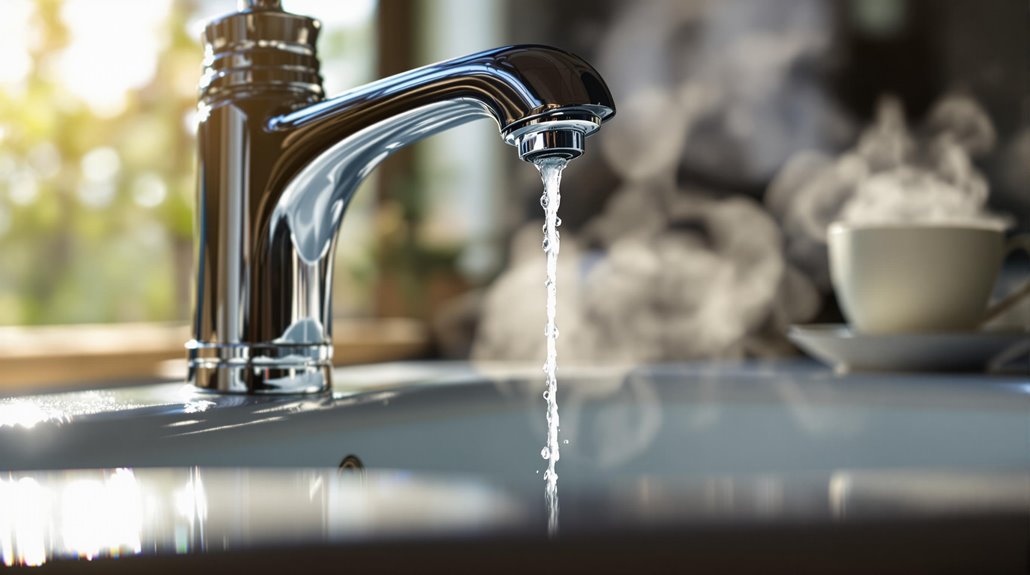
When you notice a leaky faucet, it might seem like a minor annoyance, but it can lead to significant water waste and increased utility bills over time. A single drip can waste gallons of water daily, negatively impacting both your wallet and the environment. Addressing this issue through timely faucet repair is crucial for effective water conservation. First, identify the source of the leak—often, it's a worn washer or O-ring. Once located, you can either replace the faulty component or consult a professional if you're unsure. Regular maintenance and prompt repairs not only save water but additionally extend the lifespan of your fixtures. By prioritizing faucet repair, you contribute to broader efforts in water conservation, ensuring a sustainable future. Additionally, consulting an emergency plumber can provide immediate assistance and prevent further damage.
Clogged Drains
Leaky faucets aren't the only plumbing issues that can disrupt your home; clogged drains can cause significant problems, too. When water doesn't flow freely, it can lead to backups and even flooding. To address this, regular drain cleaning is vital. You can use various plumbing tools like plungers and drain snakes to tackle minor clogs. For more stubborn blockages, consider a professional service equipped with high-pressure water jetting or video inspection technology. It's important to avoid pouring harsh chemicals down the drain, as they can damage your pipes. If you notice slow drainage or unpleasant odors, act quickly to prevent further complications. Understanding how to maintain your drains can save you time and money in the long run. Additionally, seeking emergency plumbing services can provide immediate assistance to mitigate water damage risks.
Running Toilets
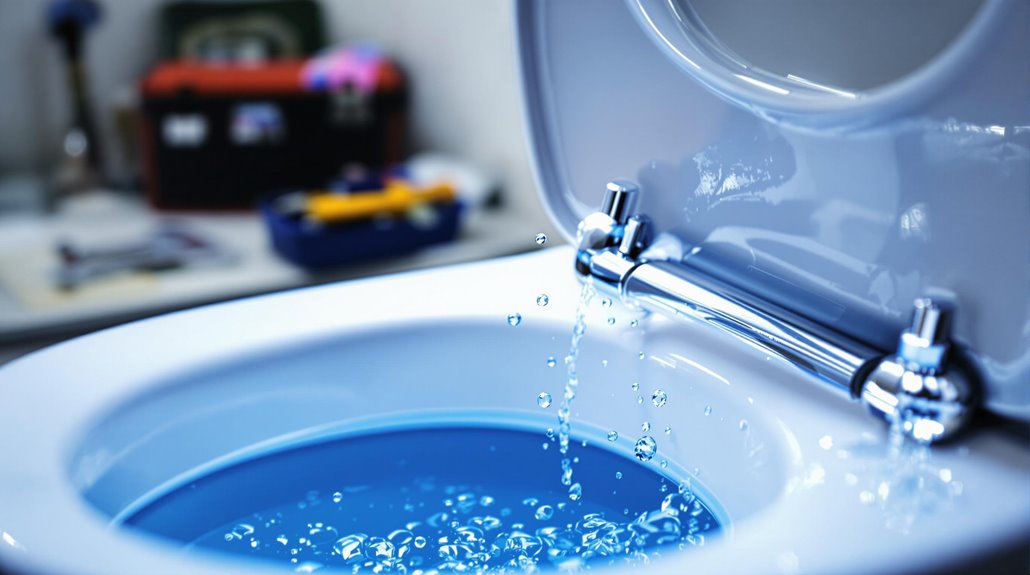
Although you might not notice it at first, a running toilet can waste a significant amount of water and increase your utility bills. Understanding the toilet mechanisms behind this issue is vital for maintaining efficiency. Common flushing issues stem from faulty flappers, worn-out fill valves, or improper adjustments.
| Common Issue | Description |
|---|---|
| Faulty Flapper | Causes water to continuously leak |
| Worn Fill Valve | Prevents proper tank filling |
| Improper Float | Affects water level in the tank |
| Chain Issues | Prevents flapper from closing fully |
Burst Pipes
As temperatures drop, the risk of burst pipes increases, often leading to severe water damage in your home. Common burst pipe causes include freezing temperatures, corrosion, and high water pressure. When water inside pipes freezes, it expands, exerting pressure that can lead to a rupture. To prevent this, insulate your pipes and keep your home heated. If you experience a burst pipe, immediate action is critical. First, turn off your main water supply to minimize damage. Next, call a professional for burst pipe repair to assess the situation and fix the issue. Timely repairs can save you from extensive damage and costly renovations, so don't hesitate to seek help when necessary.
Water Heater Issues
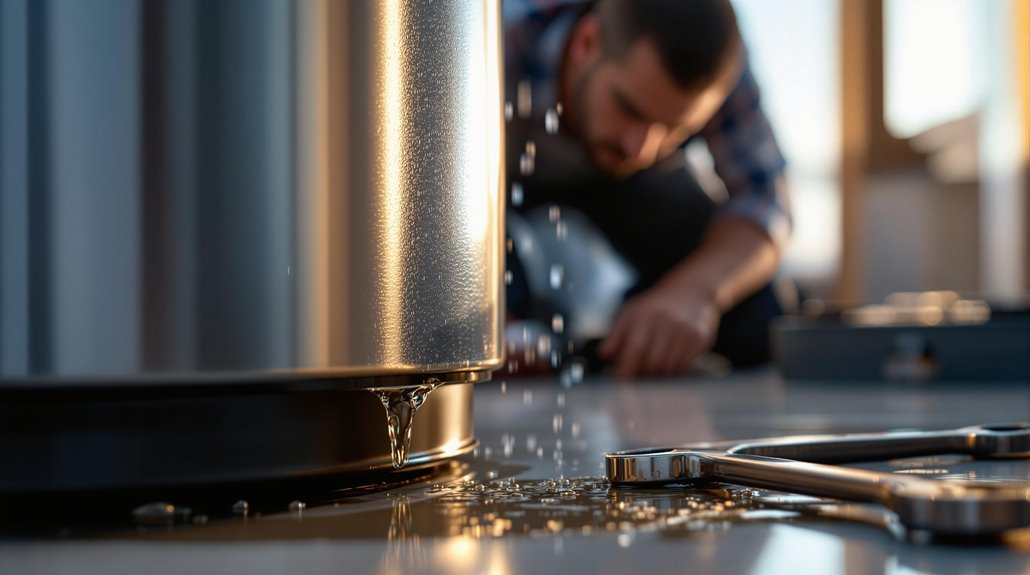
When it comes to water heaters, you might encounter several common problems, such as leaks or inadequate heating. Regular maintenance is crucial to prevent these issues and guarantee peak performance. Understanding these aspects can save you time, money, and frustration.
Common Heater Problems
Although water heaters are essential for daily comfort, they can encounter several common issues that disrupt their function. One frequent problem is insufficient hot water, often linked to thermostat issues. If your water heater isn't heating water properly, check the thermostat settings; they might need adjustment or replacement. Another common issue is strange noises, which can indicate sediment buildup. Regular heater maintenance can help prevent this, guaranteeing peak performance. Furthermore, leaks around the unit can signal failing components, requiring immediate attention. Finally, water discoloration may suggest rust in the tank, affecting both quality and safety. Recognizing these issues early can save you from costly repairs and guarantee your water heater operates efficiently.
Maintenance Tips Essential
Proper maintenance can greatly extend the life of your water heater and prevent many common issues. To guarantee peak performance, schedule regular plumbing inspections at least once a year. During these inspections, a professional can identify potential problems and recommend necessary repairs. Moreover, perform seasonal maintenance by flushing the tank to remove sediment buildup, which can affect efficiency and lifespan. Inspect the anode rod every few years; if it's greatly corroded, replace it to prevent tank rusting. Check the temperature setting, ideally keeping it at 120°F to save energy and reduce the risk of scalding. Finally, monitor for leaks or unusual noises, as these can indicate deeper issues that need immediate attention. Regular care can save you from costly emergencies.
Sewage Backup
Sewage backup is a serious plumbing emergency that can lead to significant health hazards and costly repairs. When sewage backs up into your home, it typically results from clogged pipes or a compromised sewer line. You might notice unpleasant sewage odors, indicating that waste is not flowing properly. This situation poses serious health risks because of exposure to harmful bacteria and pathogens found in sewage. It's vital to act quickly; avoid using sinks, toilets, or showers until the issue is resolved. Call a professional plumber to assess and clear the blockage safely. Moreover, consider regular maintenance to prevent future backups, ensuring your plumbing system remains in good working order. Don't underestimate the importance of prompt action in these situations.
Low Water Pressure
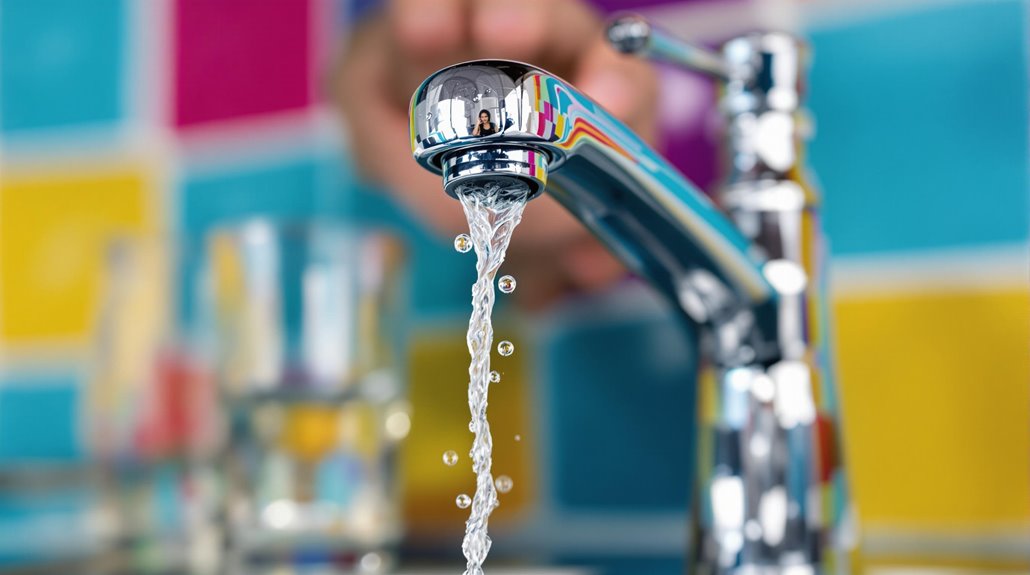
Low water pressure can disrupt your daily routines and signal underlying plumbing issues. Understanding the causes of low pressure, along with effective solutions and preventive measures, is essential for maintaining a functional plumbing system. Let's investigate how to identify and address this common problem efficiently.
Causes of Low Pressure
When you experience low water pressure, several factors could be at play, ranging from issues within your plumbing system to external influences. Understanding these causes helps you identify the problem efficiently.
| Cause | Description | Impact |
|---|---|---|
| Clogged Pipes | Mineral buildup restricts flow. | Reduces overall pressure. |
| Faulty Pressure Regulator | Malfunctioning device alters flow. | Leads to inconsistent pressure. |
| Water Supply Issues | External supply problems affect flow. | Can cause permanent low pressure. |
These issues can stem from improper pressure regulation, leading to inadequate water supply. Identifying the root cause is crucial for resolving low water pressure effectively.
Solutions and Prevention Tips
How can you effectively tackle low water pressure issues and prevent them from recurring? Start by scheduling regular plumbing inspections. These inspections help identify leaks or blockages that can contribute to low pressure. If you find mineral buildup in faucets or pipes, use a vinegar solution to clean them. Installing a pressure regulator can likewise help maintain consistent pressure throughout your home. Furthermore, keep an emergency kit ready with crucial tools like wrenches and replacement washers, so you're prepared for minor repairs. Remember to check your water meter; if it's running while all fixtures are off, you might have a leak. By staying proactive and addressing issues promptly, you can minimize low water pressure occurrences.
Pipe Corrosion
Though you may not notice it at first, pipe corrosion can silently wreak havoc on your plumbing system. Corrosion occurs when pipes, typically made of metal, react chemically with water, leading to deterioration. This can result in leaks, reduced water pressure, and even complete pipe failure. Regular pipe maintenance is crucial to detect early signs of corrosion, such as discoloration or leaks. You can likewise implement corrosion prevention strategies by using protective coatings or choosing non-corrosive materials for new installations. Monitor your water's pH and mineral content, as high levels of certain substances can accelerate corrosion. By staying proactive with your plumbing care, you can extend the life of your pipes and avoid costly repairs.
Garbage Disposal Problems
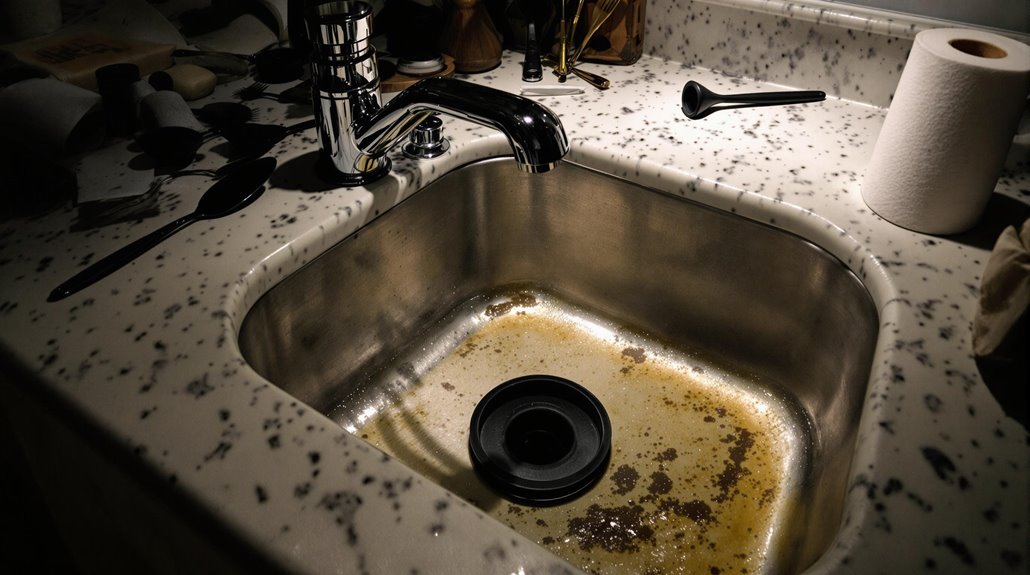
What do you do when your garbage disposal suddenly stops working? First, check the power supply and reset the unit using the reset button. If it still doesn't work, inspect for jams. Regular garbage disposal maintenance can help prevent these issues.
Here's a quick checklist:
| Step | Action |
|---|---|
| Power Check | Verify it's plugged in |
| Reset | Press the reset button |
| Jam Inspection | Remove any obstructions |
| Leak Check | Look for water pooling |
| Professional Help | Contact a plumber if needed |
If you need a new one, consider proper garbage disposal installation to avoid future problems. Following these steps guarantees your disposal operates efficiently.
Toilet Overflow
Toilet overflow can occur because of various factors, such as a clogged drain or a malfunctioning float. When this happens, it's essential to take immediate actions to prevent water damage and restore functionality. Moreover, implementing effective prevention tips can help you avoid future incidents and maintain a reliable plumbing system.
Causes of Overflow
A toilet overflow can occur due to several factors that disrupt the normal flow of waste and water. Clogs in the toilet trap or drain line are common culprits, often caused by excessive toilet paper or foreign objects. A malfunctioning flapper valve may likewise lead to continuous water flow, increasing the risk of overflow. Furthermore, issues within the plumbing venting system can create negative pressure, preventing proper drainage. To guarantee effective overflow prevention, it's vital to maintain your plumbing and avoid flushing inappropriate items. When a toilet overflow occurs, prompt emergency response is imperative to minimize water damage and restore functionality. Understanding these causes can help you address issues before they escalate into emergencies.
Immediate Actions Required
When faced with a toilet overflow, swift action is crucial to prevent extensive water damage. Start with an initial assessment of the situation. Determine the cause of the overflow—whether it's a blockage or a malfunctioning float. If you can't identify or resolve the issue quickly, shut off the water supply to the toilet, usually located behind the fixture.
Next, remove any items from the floor to minimize damage and use towels or a mop to soak up excess water. If the overflow persists, you may need to contact emergency plumbing services. Keep a list of emergency contacts handy for quick access. Promptly addressing the issue can save you from costly repairs and restore functionality to your bathroom.
Prevention Tips Offered
Preventing toilet overflows starts with regular maintenance and awareness of potential issues. Schedule routine plumbing inspections to identify any weaknesses in your toilet system, such as deteriorating parts or clogs. Pay attention to signs like slow drainage or unusual noises, as these can indicate underlying problems. Seasonal maintenance is equally important; check the flapper valve and fill valve for proper operation, and clean the toilet tank to prevent sediment buildup. Furthermore, avoid flushing inappropriate items, as this can lead to blockages. Implementing these strategies not only helps maintain your toilet's functionality but also reduces the risk of costly emergencies, ensuring peace of mind in your home.
Sump Pump Failure
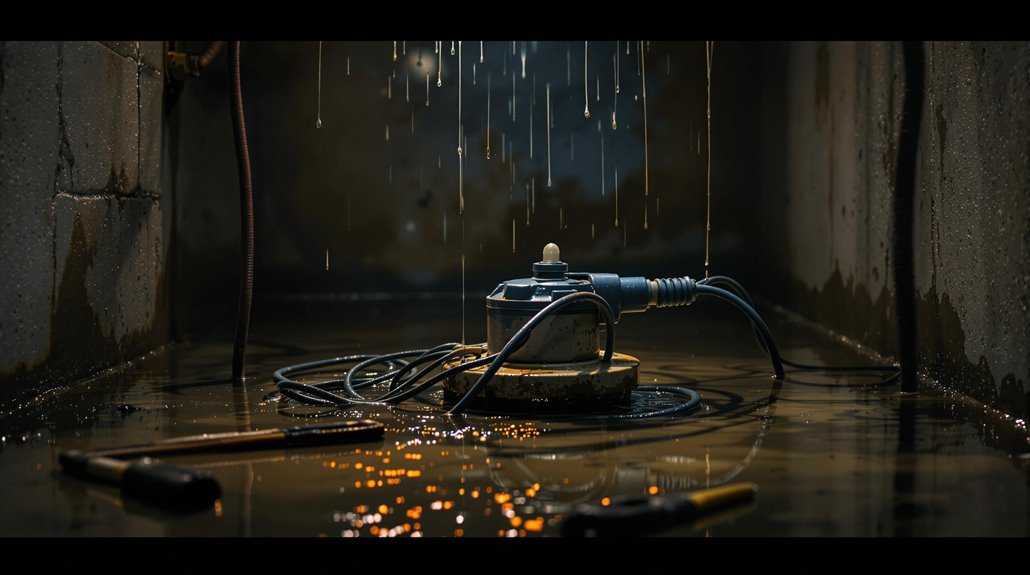
Although they're designed to protect your home from flooding, sump pumps can fail unexpectedly, leading to potential water damage. Common sump pump types include submersible and pedestal pumps, each with unique features and maintenance needs. Regular sump pump maintenance is essential; check the pump's power source, clean the sump pit, and test the float switch monthly to guarantee proper operation. If your sump pump doesn't activate during heavy rain or after a power outage, it may malfunction. Furthermore, inspect discharge lines for blockages. Addressing these issues promptly can save you from costly repairs. Remember that a well-maintained sump pump is your best defense against unwanted water in your basement or crawl space.
Frozen Pipes
As temperatures plunge, the risk of frozen pipes increases, which can lead to significant plumbing issues. To avoid this, focus on frozen pipe prevention strategies. Insulate exposed pipes in unheated areas, like basements and attics, and keep your home heated to at least 55°F. During extreme cold, let faucets drip to relieve pressure.
If you find a frozen pipe, act quickly. Implement thawing techniques by applying heat using a hairdryer or heating pad. Avoid open flames, as they can damage pipes. Start thawing near the faucet and work your way back. If the pipe remains frozen or you detect a leak, contact a professional plumber immediately to prevent extensive damage and costly repairs.
Conclusion
In conclusion, being prepared for common plumbing emergencies can save you time and money. Whether it's a leaky faucet or a frozen pipe, knowing how to address these issues is essential. Just like a knight in shining armor, you need the right tools and knowledge to tackle plumbing problems effectively. Don't wait for a disaster; stay proactive and maintain your plumbing system. Remember, a stitch in time saves nine, so handle minor issues before they escalate into major headaches.
